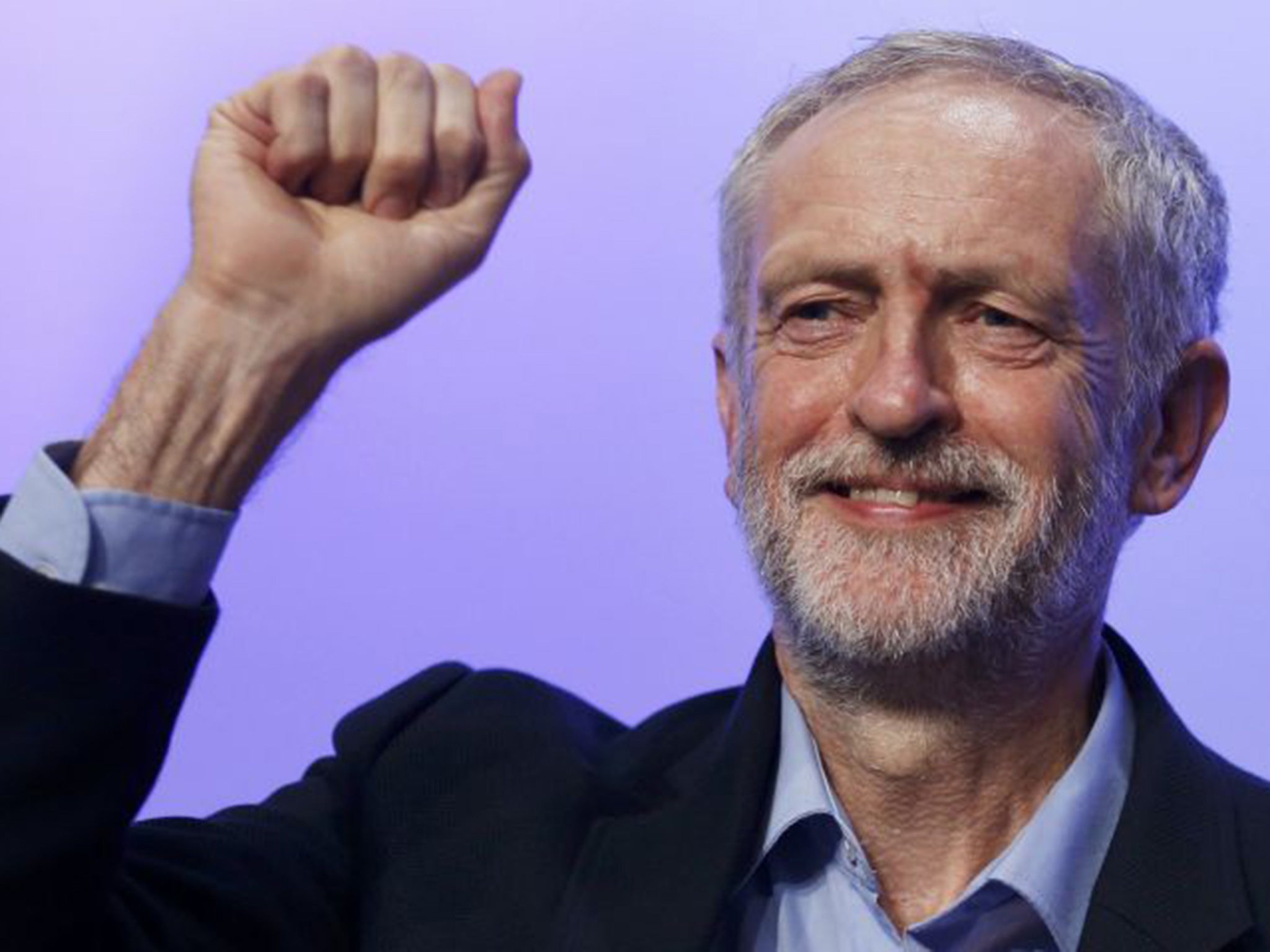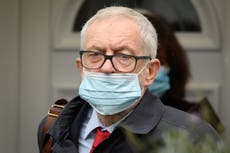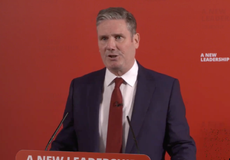The slow rise and swift fall of Jeremy Corbyn – from the fringes to the very top of Labour and back again
An outsider who ended up fighting two remarkable campaigns – for Labour leader in 2015 and the general election of 2017 – yet the wheels eventually came off for Corbyn, writes Andrew Grice


For most of his 37 years as an MP, Jeremy Corbyn was in the wilderness inside his own party. Now, after unexpectedly being at the very top of the Labour Party for the past five years, he is back on the margins to which is he accustomed. Keir Starmer has refused to restore the Labour whip to Corbyn even though Corbyn was readmitted to party membership by a panel, reversing his suspension over his response to the Equality and Human Rights Commission (EHRC) inquiry into antisemitism in the party.
I first came across Corbyn at the Labour conference of 1981, one of the most dramatic in its history. A left-right struggle came to a head in an election for the deputy leadership, with the incumbent Denis Healey challenged by left-winger Tony Benn. Corbyn, then a trade union official and Haringey councillor, worked on his hero Benn’s campaign and was his warm-up act at a series of packed, electric fringe meetings. It was a high water mark for the left but not quite high enough: Healey defeated Benn by 50.4 per cent to 49.6 per cent.
When Labour then moved to discipline members of the Trotskyist Militant tendency group, Corbyn was in the forefront of the opposition as convenor of the “stop the witch hunt” campaign. Although he was not a member of Militant or other far-left factions, this was an early display of the tolerance towards fellow left-wingers that would later cost him dearly when it came to the issue of antisemitism.
Elected MP for Islington North in 1983, the same year as Tony Blair and Gordon Brown entered the Commons, Corbyn found soulmates in the Campaign Group, proud to call themselves socialists. But as Labour moved back towards the centre under Neil Kinnock, John Smith and then Blair, the band of left-wing brothers were pushed to the party’s fringes. They kept the red flag flying at sometimes thinly attended events and press conferences.
After Blair won his landslide in 1997, Corbyn was a semi-detached member of the Parliamentary Labour Party (PLP). The most rebellious Labour MP, he defied the whip more than 400 times during the party’s 13 years in power. At one point, government whips raised the prospect of disciplinary action. Blair, his focus on governing rather than internal struggles, decided to let sleeping dogs lie. History might have been different if he had not.
Corbyn, a CND supporter who chaired the Stop the War Coalition, was a vocal critic of Blair over the 2003 invasion of Iraq. A strong backer of a united Ireland, he sparked controversy by inviting Gerry Adams and other Sinn Fein leaders to the Commons weeks after the 1984 Brighton bomb attack aimed at Margaret Thatcher.
The marginalisation of the hard left was illustrated when Corbyn’s close friend and ally John McDonnell failed to muster enough support from Labour MPs to challenge Brown for the party leadership in 2007 and 2010. Five years later, when left-wingers discussed who might try to stand to ensure a policy debate Corbyn remarked: “I suppose it’s my turn.” A 200-1 outsider to win, he said early in the contest: “Unfortunately, it’s my hat in the ring.” He confounded expectations by sneaking on to the ballot paper at the last-minute after winning nominations from MPs who did not vote for him but wanted a wider debate, including Margaret Beckett, David Lammy, Sadiq Khan and Frank Field.
What appeared to be a token stand by the left suddenly achieved unexpected momentum. At the first televised hustings, Corbyn struck a chord with the audience that surprised his rivals – the early frontrunner Andy Burnham, Yvette Cooper and Liz Kendall. True to form, Corbyn opposed the government’s welfare cuts, while Labour abstained and his fellow contenders dithered. His boldness won hearts among an electorate of party members and registered supporters which had been expanded by the previous leader Ed Miliband. When polls of those with votes emerged, it was clear that the dark horse was very much in the race, to the surprise of even his own allies.
After an effective campaign, Corbyn, then 66, won a comprehensive victory, with 60 per cent of the votes, well ahead of second-placed Burnham on 19 per cent. On the day it was announced, some Labour HQ staff wore black, a sign of the hostility towards him that would later re-emerge during the antisemitism controversy.
Some Labour MPs, too, were reluctant to accept Corbyn’s mandate. Their belief that he was unelectable as prime minister led in 2016 to the PLP passing a vote of no confidence in him, by 172 votes to 40. Many Labour MPs resigned from Corbyn’s frontbench team. A formal challenge to him as party leader was inevitable. But Owen Smith, the anti-Corbyn candidate, was wary of differentiating himself from a leader who still enjoyed the support of the grassroots membership, well organised by his Momentum fan club. Corbyn comfortably saw off the challenge, defeating Smith by 62 per cent to 38 per cent.
The Corbynsceptics were resigned to waiting for the voters to deliver the final blow to his leadership. They thought the moment had arrived when Theresa May called a snap election in 2017. They had little confidence the public would warm to Labour’s most left-wing manifesto since 1983; it included tax rises on the top 5 per cent of earners and nationalisation of the key utilities. But Corbyn again confounded his critics.
He became a different person on the campaign trail, free of the straitjacket at Westminster. Even when questioned by an overwhelmingly hostile media, he suppressed his usual tetchiness towards it. His rallies around the country were packed out. Overspill rooms and extra screens had to be provided. The cries of “Oh, Jeremy Corbyn” were not only from the already converted, but from the enthusiasm of a new, younger generation. He insisted he did not enjoy the cult of personality. Some of those close to him disagreed. “He loved it,” one told me.
Despite his brilliant campaign, his critics had their lines prepared and were ready to call for him to stand down once the results were in. The lines were never used. Corbyn deprived May of her overall majority as Labour gained 30 seats, winning 40 per cent of the votes to the Tories’ 42 per cent. It was Corbyn’s finest hour. Even his critics conceded he had earned a second shot at becoming prime minister.
But for Corbyn, that was the peak. The build-up to his second general election was dominated by Brexit, an issue which split Labour and led to a messy compromise under which Corbyn, a long-standing Eurosceptic, was pushed by his pro-European party members into supporting a Final Say referendum but said he would remain neutral in it.
The issue bedevilled Labour at last December’s election. Corbyn understandably reprised his greatest hits from the 2017 campaign and manifesto. But the rallies were more thinly attended and the public had moved on. They wanted to “get Brexit done,” or at least over and done with. Corbyn had a strong opponent in Boris Johnson, in a sharp contrast to May’s weakness.
This time, Corbyn was not a likeable outsider but a serious contender for power. He failed the test of being seen as a credible prime minister, as doubts about his stance on security – epitomised by his initial reluctance to blame Russia for its nerve agent attack in Salisbury – returned to haunt him. Johnson succeeded where May tried but failed, by demolishing the red wall of traditional Labour seats in the north and Midlands. Labour lost 59 seats in its worst election result since 1935.
Now 70, Corbyn’s resignation as leader was a formality. The catastrophic result persuaded many Labour members who still respected Corbyn to shun his preferred successor, Rebecca Long-Bailey. Instead, Keir Starmer was elected in April.
Corbyn’s 2015 Labour leadership triumph had sowed the seeds of the controversy over antisemitism that would later send him back to the wilderness. His election acted as a magnet for many left-wingers who had drifted away from Labour in the Blair-Brown era. The surge in the party’s membership to 550,000, the largest in western Europe, was a remarkable achievement.
But the influx included some whose support for the Palestinian cause sometimes crossed a line. Corbyn, who wanted a “kinder, gentler politics,” was slow to realise how damaging the row could become. He was initially reluctant to move against old allies such as Ken Livingstone – who has "fully rejected" any accusations against him.
Many Labour MPs were convinced that his own strongly pro-Palestinian views gave him a blind spot on the issue. His failure to see the potential damage led to a deep rift with McDonnell, his closest ally, in which they did not speak to each other for months during the summer of 2018. The shadow chancellor was ready to do whatever it took to have a chance of winning power; Corbyn was not.
Indeed, he and his team were woeful when it came to party management; their hatred of “the MSM” (mainstream media) bred a counter-productive stubborn streak. His aides, rightly confident Corbyn did not have a racist bone in his body, were sure the allegations were whipped up and magnified by his enemies within the party and in the media. As the inquiry by the Equality and Human Rights Commission (ECHR) has now confirmed, Corbyn’s office was closely involved in the handling of complaints and influencing which ones should be investigated.
Corbyn’s default position was to play the victim. He is still doing it today. To his critics, he remains in denial about the scale of the problem, even after the ECHR report. This did not single him out for blame, but found a collective failure at the top of the party. Initially, Starmer appeared wary of taking disciplinary action against his predecessor. But Corbyn played into Starmer’s hands with a characteristically unrepentant statement insisting the party’s problem has been "dramatically overstated for political reasons." Labour responded by suspending Corbyn and withdrawing the party whip.
After 19 days, and peace moves by his allies, it appeared that Corbyn might return swiftly from the wilderness. He clarified his controversial statement, saying concerns about antisemitism are “neither ‘exaggerated’ nor ‘overstated.’” But characteristically, he did not apologise for his original response to the EHRC report. “Jeremy doesn’t do contrition,” said one long-time ally who believes he mishandled the affair.
Corbyn’s words were enough for a national executive committee (NEC) panel to allow him to return as a member, however. But they were not enough for Starmer, who bowed to pressure from Corbynsceptic Labour MPs not to restore the whip. Unless the decision is reversed, Corbyn could not be a Labour candidate at the next election, bringing his long career to an end. Starmer’s move sparked another outbreak of Labour civil war; it could have been avoided if Corbyn had reacted differently to the EHRC inquiry.
Labour’s civil war was never really very far below the surface during Corbyn’s unexpected reign in the party. Both sides were to blame: the critics who never respected his mandate and his acolytes accused of intimidating and bullying his opponents. Whatever the final verdict on his leadership, it was not a “kinder, gentler politics.”
Against all the odds, Corbyn fought two remarkable campaigns, one for leader of Labour in 2015 and the other the general election of 2017. In opposing austerity, he was in tune with the public mood and did shift the dial of British politics. But he did not, as he claimed after Johnson’s government began throwing billions at fight against coronavirus, win the argument.
Conversely, Corbyn left his party with the mammoth task of reclaiming the red wall which, despite Johnson’s current woes in the north, might well take more than one election.




Join our commenting forum
Join thought-provoking conversations, follow other Independent readers and see their replies
Comments